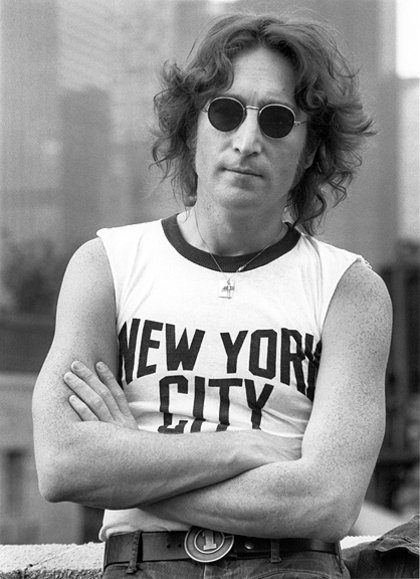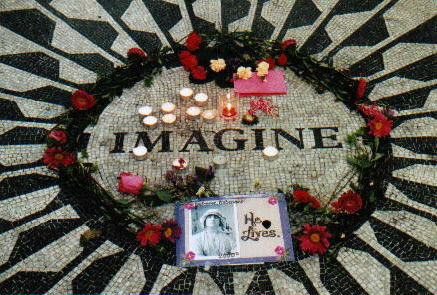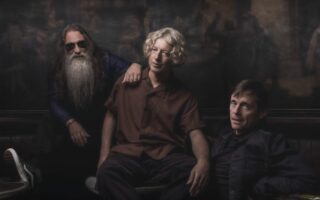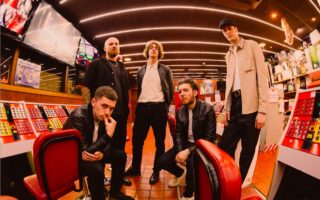John Lennon, one of the most influential songwriters and musicians of all time, was born on October 9th, 1940 in Liverpool.
John’s early childhood was a disruptive one; spending the first few years of his life under the care of his mother Julia, the small family was supported with cheques sent from abroad by their merchant seaman husband and father Alf. However, when Alf’s income was halted after going AWOL, Julia eventually handed the care of John over to her sister, Mimi. Then, in 1946 when John was 6, his father intended to emigrate with his son to New Zealand but, after being confronted by Julia in Blackpool, John eventually chose to stay in England.
John remained with his Aunt Mimi for the rest of his childhood, although he would often visit his mother, who first introduced John to the then burgeoning US rock n roll scene by playing Elvis records and teaching him banjo. She would eventually buy him his first guitar in 1957, when John was at the relatively advanced age of 17.
John’s world was shattered a year later when his mother was killed by a car driven by an off-duty police officer, not far from where he was living with Aunt Mimi. Despite spending most of their lives apart, John and his mother had become very close as he had grown up, brought together by their mutual love of music which Julia would egg John on to pursue, as opposed to Mimi who tried to discourage him from following that particular path. Almost certainly as a result of the death of his mother, John failed his O-Levels, and after being shoe-horned into Liverpool Art College by both Mimi and a decidedly dubious headmaster, he would often be disruptive in classes, and ultimately dropped out before completing the course.
Before he joined the Liverpool Art College, John had formed his first band, The Blackjacks, with school friends Eric Griffiths and Pete Shotton. Ahead of their first gig, the group’s name had been changed to The Quarrymen and, after a few inevitable line-up changes, the young band began playing in local skiffle contests, parties and fetes around Liverpool. It was while playing at a fete with The Quarrymen that John first met his future songwriting partner, Paul McCartney, on 6th July 1957. Following a short meeting with the fledgling bandmates before an evening performance, McCartney was asked to join the group – an invitation he eventually took up after a family holiday to Yorkshire. Several successful rehearsals ensued, and John and Paul appeared at their first gig together in October 1957. Soon after, at the insistence of Paul, John allowed a 15 year old local school boy by the name of George Harrison to join the band as lead guitarist.
Paul and John began writing songs together almost immediately, and after more name changes, The Beatles became a regular fixture on Liverpool’s live circuit from 1960 onwards. Two stints in Hamburg in the early 60s made the boys men, and The Beatles later signed to Parlophone in May 1962. Despite leaving their producer George Martin unimpressed after early recording sessions, John and Paul’s songwriting was improving every day, and debut single proper ‘Love Me Do‘, of October ’62, was succeeded by the pair’s first UK no.1 single, ‘From Me To You‘, in March ’63.
With the Lennon/McCartney songwriting collaboration blossoming all the time, they would begin to write more independently as the Sixties progressed, and by 1965, with the release of ‘Rubber Soul’, John was starting to truly display the prestigious talent which was to become legendary. Songs such as ‘In My Life‘, ‘Nowhere Man‘ and the single ‘Help!‘ displayed some of the first examples of Lennon’s very personal lyrical matter, while others, including ‘Norwegian Wood‘, offered the first hints of his desire to move into new, uncharted sonic territory. His evolution continued in earnest in 1966, as tracks such as ‘Rain‘, the b-side to ‘Paperback Writer‘, as well as contributions to ‘Revolver‘ such as ‘I’m Only Sleeping‘ and especially ‘Tomorrow Never Knows‘, displayed the innovation and creativity in the studio which John was forging.
It was also in 1966 when John caused controversy in America. After an interview with the Evening Standard – which contained his now infamous ‘…we’re more popular than Jesus’ quote – was published in the US, John and The Beatles became hate figures in large parts of the South and Mid-West areas of the country, where residents were urged to bring their Beatles collections along to public burnings by evangelical radio DJs intent on stoking the flames of a backlash. Their stations boycotted any Beatles music, and on their next tour of the US, in August 1966, John faced the media in Chicago to defend the comments in what is now one of the most famous exchanges in modern musical history:
Lennon: “I suppose if I had said television was more popular than Jesus, I would have gotten away with it, but I just happened to be talking to a friend and I used the words Beatles as a remote thing, not as what I think – as Beatles, as those other Beatles like other people see us. I just said they are having more influence on kids and things than anything else, including Jesus. But I said it in that way which is the wrong way.”
Reporter: “Some teenagers have repeated your statements – ‘I like the Beatles more than Jesus Christ.’ What do you think about that?”
Lennon: “Well, originally I pointed out that fact in reference to England. That we meant more to kids than Jesus did, or religion at that time. I wasn’t knocking it or putting it down. I was just saying it as a fact and it’s true more for England than here. I’m not saying that we’re better or greater, or comparing us with Jesus Christ as a person or God as a thing or whatever it is. I just said what I said and it was wrong. Or it was taken wrong, and now it’s all this.”
Reporter: “But are you prepared to apologise?”
Lennon: “I wasn’t saying whatever they’re saying I was saying. I’m sorry I said it really. I never meant it to be a lousy anti-religious thing. I apologise if that will make you happy. I still don’t know quite what I’ve done. I’ve tried to tell you what I did do but if you want me to apologise, if that will make you happy, then OK, I’m sorry.”
1966 was the year The Beatles stopped touring and John’s songwriting duly continued to develop as the band devoted more and more of their time to the studio. He and his fellow band members continued to push Abbey Road to its limits, exploring new avenues and ideas during a period which saw them release, amongst others, ‘Sgt.Pepper’s Lonely Hearts Club Band‘, ‘The White Album‘ and ‘Abbey Road‘, as well as singles such as ‘Strawberry Fields Forever‘, ‘Hey Jude‘ and ‘All You Need Is Love‘, in doing so cementing a period of creativity which is arguably unrivalled in the history of popular music.
In many ways, 1966 was a landmark year for John: as discussed The Beatles released ‘Revolver‘ and also decided to stop touring, and as well as his brush with the American Bible Belt, he also met his future wife, an eccentric artist named Yoko Ono who would dominate the remainder of his life. There are conflicting accounts as to how John first met Yoko, but the most widely accepted version is that they had a brief encounter at a London art exhibition, where Ono was displaying her ‘Hammer In a Nail’ piece, an installation which intrigued John. The pair remained in touch, and began a relationship primarily after The Beatles returned from India in 1968. John was still married to his first wife Cynthia at the time, and she soon filed for divorce on the grounds of adultery. Heavily influenced by drugs during this period, John’s actions are far from commendable, but he and Yoko became inseparable. Yoko would attend recording sessions for the remainder of The Beatles’ career, an act which is seen by some to have if not instigated, then certainly quickened the break up of the band. They married in Gibraltar in 1969, and left the UK for New York in 1971. Lennon would never again permanently return to Britain.
In 1970, The Beatles ended months of speculation by announcing their decision to split. Just a few months on, John had released his first solo studio record, ‘John Lennon/Plastic Ono Band’, in the December of that year. A critical and commercial success, the LP quickly established John as a viable solo artist, and laid bare many of the inner emotional demons which he had been battling since childhood. It’s cathartic, gritty, deeply personal and, perhaps, his greatest single achievement.
During this period John and Yoko immersed themselves in the political issues of the day, most prominently in the anti-Vietnam movement. In 1969 they engaged in their famous ‘Bed-In’ protest against the Vietnam War during their honeymoon, and later released politically charged tracks such as ‘Power To The People‘, ‘Give Peace a Chance‘ and the 1971/2 Christmas hit ‘Merry Xmas (War Is Over)‘. Perhaps John’s most enduring hit, ‘Imagine‘ was also born out of this period. Again containing the humanitarian theme that dominated this period, it established his legacy beyond The Beatles. Released in the US in 1971 and the UK in 1975, it is now one of the most recognisable hits ever, and is a regular in most ‘Greatest Songs Of All Time’ lists.
Four further studio albums followed 1971’s ‘Imagine‘, along with various collaborations with the likes of David Bowie, Mick Jagger and his former Beatles chum Ringo Starr, before a performance on A Salute To Lew Grade in April 1975 marked the beginning of a self-imposed exile. The rest of the Seventies were a quiet time for John. He absorbed himself in the role of a house-husband, and public appearances became rare as he concentrated his time on family life after the birth of second son Sean. John’s mindset, and pressures from the outside world during this era, are documented on ‘Watching The Wheels‘, and in 1977, John explained: “We have basically decided, without any great decision, to be with our baby as much as we can until we feel we can take time off to indulge ourselves in creating things outside of the family.”
Eventually, in November 1980, John re-emerged with the album ‘Double Fantasy‘. A genuine hit with fans and critics alike, it reflected Lennon at the most contented and settled point of his life. With his passion for music re-ignited, he was back recording and mixing new tracks in New York less than a month after the album’s release…
And so it was that on the night of 8th December 1980, John was in the studio with Yoko and producer Jack Douglas to record the track ‘Walking On Thin Ice‘. John’s contentment and happiness during this time was later recalled by Douglas, who said: “The last time I saw John he had this incredible smile on his face. It was the evening we finished ‘Walking On Thin Ice’. He was just thrilled, and so was Yoko, because we all knew we had accomplished what John set out to do with that track. I walked him to the elevator and said goodnight. About 40 minutes later my girlfriend came to the studio, all white. ‘It’s just been on the radio,’ she said. ‘John was shot’.”
After leaving the studio, John decided against eating out so he could see his young son before he went to sleep, and arrived back at the Dakota building shortly before 11pm. Upon following Yoko into the building’s reception area, he was approached by Mark David Chapman, a man he had encountered hours earlier demanding an autograph, and who on this meeting fired five gunshots, hitting John in the back and shoulder. Lennon staggered into the lobby and declared simply, “I’m shot”, before collapsing.
After arriving at Roosevelt Hospital twenty minutes later, John Lennon was pronounced dead due to catastrophic blood loss – it had taken just a matter of seconds for John’s life, with all its genius, controversy and love, to be cruelly brought to an abrupt, premature end.
Yet since then, his legend has only grown stronger as new generations discover the music of one of the most enduring cultural icons of the 20th century – continuing forever a legacy that will shine on like the moon, and the stars, and the sun.
John Lennon in his own words. Interviews from 1980 with John Lennon and Yoko Ono: “Testimony – The Life And Times Of John Lennon “






A beautiful and succinct summation of a remarkable man. Here in Delray, Florida the local art centre threw a huge Lennon Birthday Party around the exhibition of photographs that were on show in Liverpool all summer – Give Peace A Chance http://www.artvisionexhibitions.com. Over 30 large format images taken in 1969 in Montreal by Gerry Deiter who died in 2005. Hundreds of people laughed, a band rocked, Ben and Jerry’s served Whirled peace ice cream, there was cake, tears and joy at what Lennon’s legacy o peace and music is. God bless Yoko for her unconditional love and tireless efforts for more love in the world. A book is available in the UK published by Wiley & Sons. Check it out. Review it. Give Peace A Chance by Joan Athey.
Imagine an entire world living in peace… John saw the beauty and inherent good in humanity. I tried to do his legacy justice and channel his world-embracing and loving energy this week with a tribute portrait inspired by his music and his passion for changing the world. You can see this new work of art in memoriam on my artist’s blog at http://dregstudiosart.blogspot.com/2011/12/john-lennon-just-imagine.html along with some pictures showing how I created it. See John holding the Universe in his hand and spreading his message. When you stop by, let me know how his words and music have affected your life and creativity!